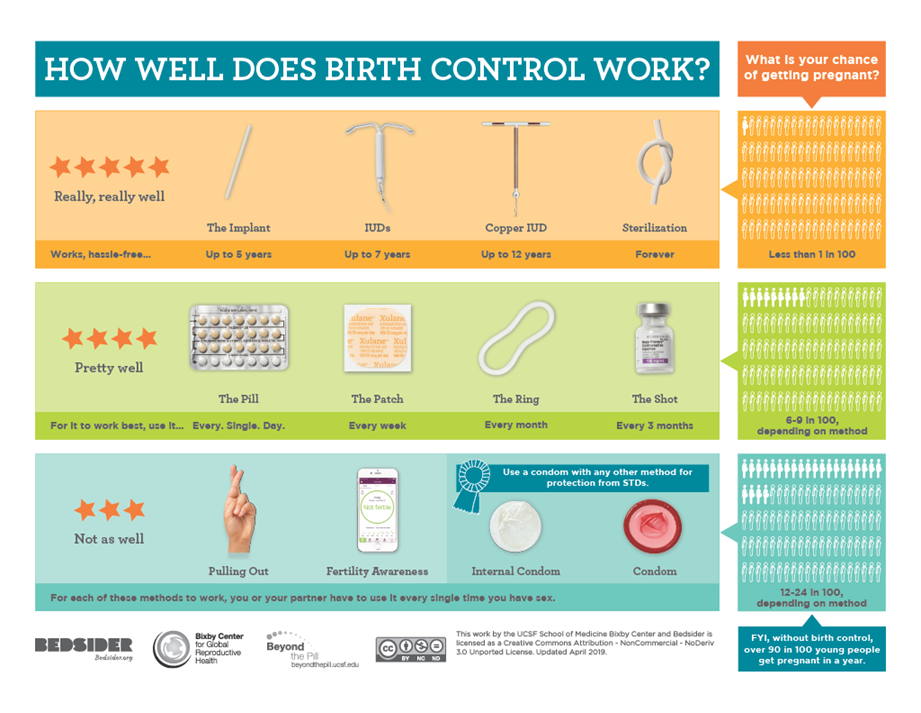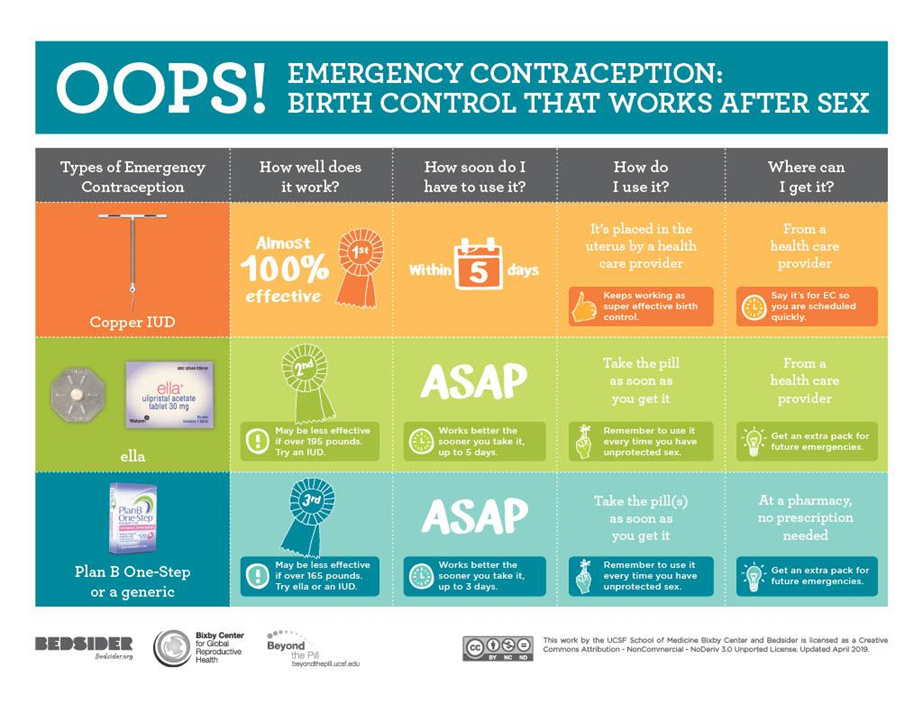12.2: Contraception
- Page ID
- 167228
As we continue through our understanding of human sexuality, at this point it has become clear that sexual activity reaches far beyond the need to procreate. Humans throughout history have enjoyed the pleasure of sex without the purpose of procreation. Contraception is a technique that prevents a sperm cell and an ovum from uniting. Controlling fertility is something that is done to avoid pregnancy, and there are various options of birth control currently available. There are many birth control options: permanent, intrauterine devices (IUDs), hormonal, barrier, spermicidal and behavioral. It is important to note that when no birth control is used, 85 out of 100 sexually active women of childbearing age become pregnant in a year (Britton, et al, 2019). From very low maintenance options to ones that must be used every time a person has sex, the choices range and it is best to find the type of birth control that works for you and your lifestyle. Proper use of the choice of birth control is critical in preventing unwanted pregnancy. These methods vary in the ways in which they prevent pregnancy as well. Some, like condoms and cervical caps, can physically block sperm from reaching the eggs, while hormonal methods like the pill or birth control injections work with a woman's hormones to prevent ovulation. Other methods like fertility awareness, sometimes known as the rhythm method, require the person to know where their body is in its fertility cycle. There are also more permanent methods like vasectomy and tubal ligation which are surgical options. There are a variety of options to choose from and new options become available periodically, so be sure to double check with a healthcare provider to see what may be available. All people regardless of their ability to become pregnant are also at risk for Sexually Transmitted Infections (STIs aka STDs). Condoms are the only birth control method that also prevents infection transmission.
Planned Parenthood is one of the leading organizations in the United States that offers free or low cost birth control options. They offer support for various types of reproductive services. They have created an easily accessible site entitled: Birth Control Options and which is best for you which goes into greater detail about each method. The infographic below highlights some of the more popular forms of birth control currently available and how well they work to prevent unwanted pregnancy.

This short video describes a vasectomy. As described in this video, a vasectomy is a procedure in which a small section of the ductus (vas) deferens is removed from the scrotum. This interrupts the path taken by sperm through the ductus deferens. If sperm do not exit through the vas, either because the person has had a vasectomy or has not ejaculated, do you know what region of the testis they remain in?
Used consistently and effectively based on the individual methods and instructions, pregnancy can be prevented. Coupling hormonal methods (pill, patch, etc.) with barrier methods (condoms) increases the effectiveness rate AND prevents the spread of STIs, so doubling up is always a good option. When preventative birth control fails, there are also emergency contraceptive options sometimes referred to as plan b that are available.

A Brief History of The Pill
It is important to note that while humans sought to enjoy sex without a desire to procreate, for most of history there was not an option that gave women autonomy over their reproductive health in the way that the pill did. “The birth control pill separated sexual practice from conception, forcing re-assessment and reevaluation of social, political, and religious viewpoints” (Liao & Dollin, 2012, para 1). In essence, the pill changed the power dynamic which was part of women’s liberation. After animal experiments in the 1930s demonstrated that high levels of progesterone could stop ovulation, Mexican Chemist Dr. Carl Djerassi synthesized progestin from Mexican Yam root. Dr. Djerassi did this work in the late 1940s, at a time when women’s rights and reproductive freedom were not a cultural norm for most women in the U.S. and in most places worldwide. Despite this, the first birth control pill was approved by the United States Food and Drug Administration (FDA) in 1960 and control over reproductive rights became possible for women. Depending on the nation and its date of approval of the drug, worldwide dates of pill availability vary. More on the history of the pill here.
A name to know in the development of hormonal birth control is Dr. Percy Julian. Dr Julian was the grandchild of slaves who went on to work on the chemical synthesis of medicinal drugs from plants. This work led to the synthetic chemicals used in hormonal birth control pills. His work to advance the birth control pill was just one area of contribution to the field yet his path was fraught with roadblocks because he was Black.

A Bit more on Hormonal Birth Control
Birth control pills take advantage of the negative feedback system that regulates the ovarian and menstrual cycles to stop ovulation and prevent pregnancy. Typically they work by providing a constant level of both estrogen and progesterone, which negatively feeds back onto the hypothalamus and pituitary, thus preventing the release of FSH and LH. Without FSH, the follicles do not mature, and without the LH surge, ovulation does not occur. Although the estrogen in birth control pills does stimulate some thickening of the endometrial wall, it is reduced compared with a normal cycle and is less likely to support implantation.
Some birth control pills contain 21 active pills containing hormones, and 7 inactive pills (placebos). The decline in hormones during the week that the woman takes the placebo pills triggers menses, although it is typically lighter than a normal menstrual flow because of the reduced endometrial thickening. Newer types of birth control pills have been developed that deliver low-dose estrogens and progesterone for the entire cycle (these are meant to be taken 365 days a year), and menses never occurs. While some women prefer to have the proof of a lack of pregnancy that a monthly period provides, menstruation every 28 days is not required for health reasons, and there are no reported adverse effects of not having a menstrual period in an otherwise healthy individual.
Because birth control pills function by providing constant estrogen and progesterone levels and disrupting negative feedback, skipping even just one or two pills at certain points of the cycle (or even being several hours late taking the pill) can lead to an increase in FSH and LH and result in ovulation. It is important, therefore, that the woman follow the directions on the birth control pill package to successfully prevent pregnancy.


